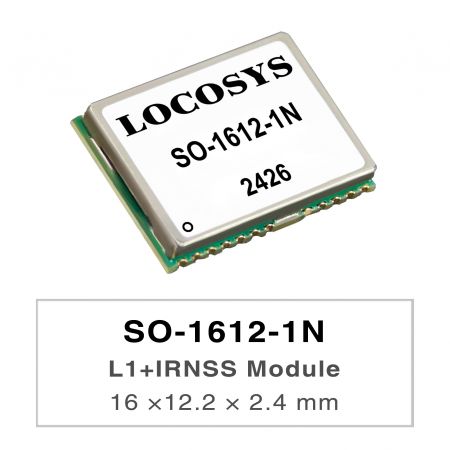-
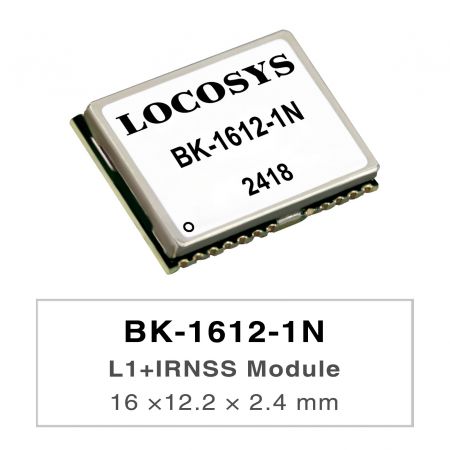
BK-1612-1N
BK-1612-1N
The BK-1612-1N is a receiving module that supports dual-band and GPS, GLONASS, GALILEO, BEIDOU, QZSS & NavIC Multi-mode. It has built-in highly integrated receiver chip, supports multi band and multi system cm4f (main frequency 350mhz, 22nm Technology) chip. Besides, it is capable of tracking all global civil navigation systems (GPS, GLONASS, GALILEO, BEIDOU, QZSS, NavIC ) in band L1 and L5. BK-1612-1N module is based on the state of art NavIC architecture, integrating multi-band and multi-system GNSS RF and base band. This newly designed architecture makes this single chip achieve sub-meter level positioning accuracy without correction data from ground-based augmentation station and higher sensitivity, greater for improved jam resistance and multipath, provide a highly robust service in complicated environment. BK-1612-1N module featuring high sensitivity, low power consumption, and fast TTFF. The superior cold start sensitivity allows it to acquire, track, and get position fix autonomously in difficult weak signal environment. The receiver’s superior tracking sensitivity allows continuous position coverage in nearly all outdoor application environments. The high performance signal parameter search engine is capable of testing 16 million time-frequency hypotheses per second, offering superior signal acquisition and TTFF speed.
-

MC-1010-V3a
MC-1010-V3a
LOCOSYS MC-1010-Vxx series are high-performance dual-band GNSS positioning modules that are capable of tracking all global civil navigation systems. They adopt 12 nm process and integrate efficient power management architecture to perform low power and high sensitivity. Besides, concurrent reception of L1 and L5 band signals mitigates the multipath delay and achieves sub-meter position accuracy. The modules support hybrid ephemeris prediction to achieve faster cold start. One is self-generated ephemeris prediction (called EPOC) that is no need of both network assistance and host CPU’s intervention. This is valid for up to 3 days and updates automatically from time to time when GNSS module is powered on and satellites are available. The other is server-generated ephemeris prediction (called EPO) that gets from an internet server. This is valid for up to 14 days. Both ephemeris predictions are stored in the on-board flash memory and perform a cold start time less than 15 seconds. MC-1010-V3x with the active antenna can comply with the sensitivity specification contained in AIS 140 standard. It is the best solution to those customers that design tracking applications in compliance with AIS 140.
-

MC-1010-V3b
MC-1010-V3b
LOCOSYS MC-1010-Vxx series are high-performance dual-band GNSS positioning modules that are capable of tracking all global civil navigation systems. They adopt 12 nm process and integrate efficient power management architecture to perform low power and high sensitivity. Besides, concurrent reception of L1 and L5 band signals mitigates the multipath delay and achieves sub-meter position accuracy. The modules support hybrid ephemeris prediction to achieve faster cold start. One is self-generated ephemeris prediction (called EPOC) that is no need of both network assistance and host CPU’s intervention. This is valid for up to 3 days and updates automatically from time to time when GNSS module is powered on and satellites are available. The other is server-generated ephemeris prediction (called EPO) that gets from an internet server. This is valid for up to 14 days. Both ephemeris predictions are stored in the on-board flash memory and perform a cold start time less than 15 seconds. MC-1010-V3x with the active antenna can comply with the sensitivity specification contained in AIS 140 standard. It is the best solution to those customers that design tracking applications in compliance with AIS 140.
-

MC-1612-V3b
MC-1612-V3b
LOCOSYS MC-1612-Vxx series are high-performance dual-band GNSS positioning modules that are capable of tracking all global civil navigation systems. They adopt 12 nm process and integrate efficient power management architecture to perform low power and high sensitivity. Besides, concurrent reception of L1 and L5 band signals mitigates the multipath delay and achieves sub-meter position accuracy. The modules support hybrid ephemeris prediction to achieve faster cold start. One is self-generated ephemeris prediction (called EPOC) that is no need of both network assistance and host CPU’s intervention. This is valid for up to 3 days and updates automatically from time to time when GNSS module is powered on and satellites are available. The other is server-generated ephemeris prediction (called EPO) that gets from an internet server. This is valid for up to 14 days. Both ephemeris predictions are stored in the on-board flash memory and perform a cold start time less than 15 seconds The RF front end of MC-1612-V3b the module is specifically designed to comply with sensitivity specification contained in AIS 140 standard. It is the best solution to those customers that design tracking applications in compliance with AIS 140.
-
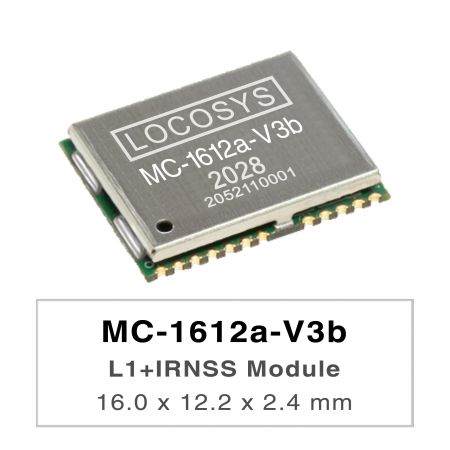
MC-1612a-V3b
MC-1612a-V3b
LOCOSYS MC-1612a-Vxx is a high-performance dual-band GNSS positioning module that is capable of tracking all global civil navigation systems. It adopts 12 nm process and integrates efficient power management architecture to perform low power and high sensitivity. Besides, concurrent reception of L1 and L5 band signals mitigates the multipath delay and achieves more accurate position. The module supports hybrid ephemeris prediction to achieve faster cold start. One is self-generated ephemeris prediction (called EPOC) that is no need of both network assistance and host CPU’s intervention. This is valid for up to 3 days and updates automatically from time to time when GNSS module is powered on and satellites are available. The other is server-generated ephemeris prediction (called EPO) that gets from an internet server. This is valid for up to 14 days. Both ephemeris predictions are stored in the on-board flash memory and perform a faster cold start. The RF front end of MC-161a-V3b the module is specifically designed to comply with sensitivity specification contained in AIS 140 standard. It is the best solution to those customers that design tracking applications in compliance with AIS 140.
-
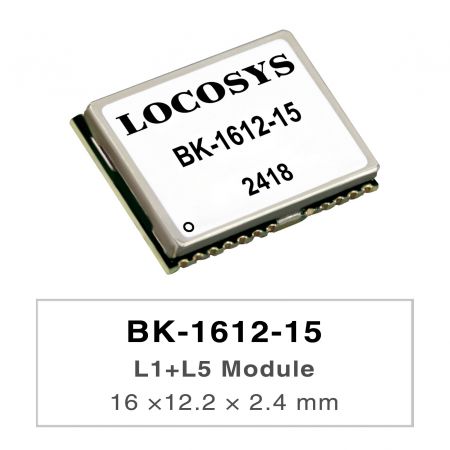
BK-1612-15
BK-1612-15
The BK-1612-15 is a receiving module that supports Dual-Band & Multi-Mode. It has built-in highly integrated GNSS receiver chip, supports multi band and multi system cm4f (main frequency 350Mhz, 22nm Technology) chip of Third-generation BEIDOU Navigation Satellite System (BDS-3). Besides, it is capable of tracking all global civil navigation systems (GPS, GLONASS, GALILEO, BEIDOU, QZSS, and SBAS) in allbands. BK-1612-15 module is based on the state of art BDS-3 architecture, integrating multi-band and multi-system GNSS RF and baseband. This newly designed architecture makes this single chip achieve sub-meter level positioning accuracy without correction data from ground-based augmentation station and higher sensitivity, greater for improved jam resistance and multipath, provide a highly robust service in complicated environment. BK-1612-15 module contains positioning engine inside, featuring high sensitivity, low power consumption, and fast TTFF. The superior cold start sensitivity allows it to acquire, track, and get position fix autonomously in difficult weak signal environment. The receiver’s superior tracking sensitivity allows continuous position coverage in nearly all outdoor application environments. The high-performance signal parameter searching engine is capable of testing 16 million time-frequency hypotheses per second, offering superior signal acquisition and TTFF speed.
-
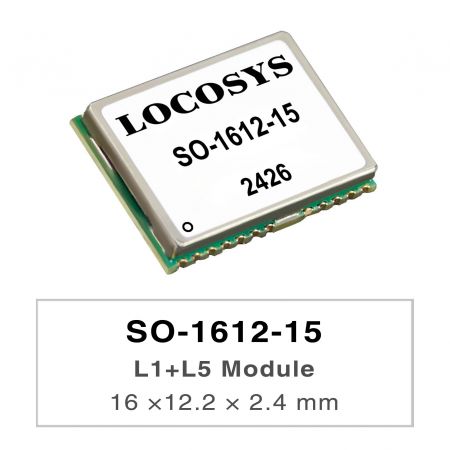
SO-1612-15
SO-1612-15
SO-1612-15 is a dual-band GNSS positioning receiving modules that a capable of tracking all global civil navigation systems (BDS, GPS, GLONASS, Galileo, QZSS, IRNSS and SBAS) in all band bands. Built-in highly integrated GNSS receiving chip supports the third generation Beidou Satellite Navigation System (BDS-3). SO-1612-15 module is based on the state of art BDS-3 architecture, integrating multi-band and multi-system GNSS RF and baseband. This newly designed architecture makes this single chip achieve sub-meter level position accuracy without correction data from ground-based augmentation station and higher sensitivity, greater for improved jam resistance and multipath, provide a highly robust service in complicated environment. SO-1612-15 module contains CXD5610GF positioning engine inside, featuring high sensitivity, low power consumption, and fast TTFF. The superior cold start sensitivity allows it to acquire, track, and get position fix autonomously in difficult weak signal environment. The receiver’s superior tracking sensitivity allows continuous position coverage in nearly all outdoor application environments.
-
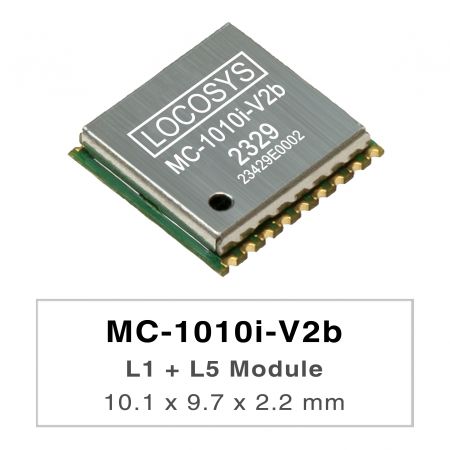
MC-1010i-V2b
MC-1010i-V2b
LOCOSYS MC-1010i-V2b is a high-performance dual-band GNSS positioning module that can track all global civil navigation systems. It adopts 12 nm process and integrates efficient power management architecture to perform low power and high sensitivity. Besides, concurrent reception of L1 and L5 band signals mitigates the multipath delay and achieves more accurate position. The module supports hybrid ephemeris prediction to achieve faster cold start. One is self-generated ephemeris prediction (called EPOC) that is no need of both network assistance and host CPU’s intervention. This is valid for up to 3 days and updates automatically from time to time when GNSS module is powered on and satellites are available. The other is server-generated ephemeris prediction (called EPO) that gets from an internet server. This is valid for up to 14 days. Both ephemeris predictions are stored in the on-board flash memory and perform a cold start time less than 15 seconds.
-
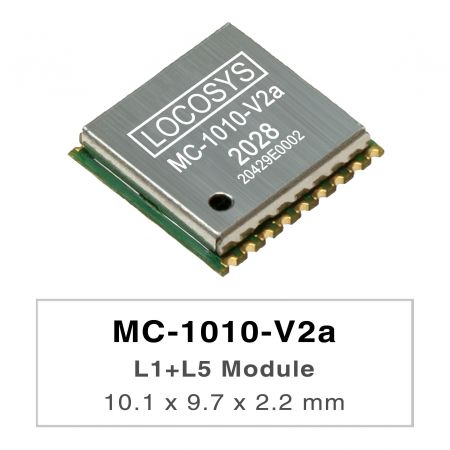
MC-1010-V2a
MC-1010-V2a
LOCOSYS MC-1010-Vxx series are high-performance dual-band GNSS positioning modules that are capable of tracking all global civil navigation systems. They adopt 12 nm process and integrate efficient power management architecture to perform low power and high sensitivity. Besides, concurrent reception of L1 and L5 band signals mitigates the multipath delay and achieves sub-meter position accuracy. The modules support hybrid ephemeris prediction to achieve faster cold start. One is self-generated ephemeris prediction (called EPOC) that is no need of both network assistance and host CPU’s intervention. This is valid for up to 3 days and updates automatically from time to time when GNSS module is powered on and satellites are available. The other is server-generated ephemeris prediction (called EPO) that gets from an internet server. This is valid for up to 14 days. Both ephemeris predictions are stored in the on-board flash memory and perform a cold start time less than 15 seconds. MC-1010-V3x with the active antenna can comply with the sensitivity specification contained in AIS 140 standard. It is the best solution to those customers that design tracking applications in compliance with AIS 140.
-
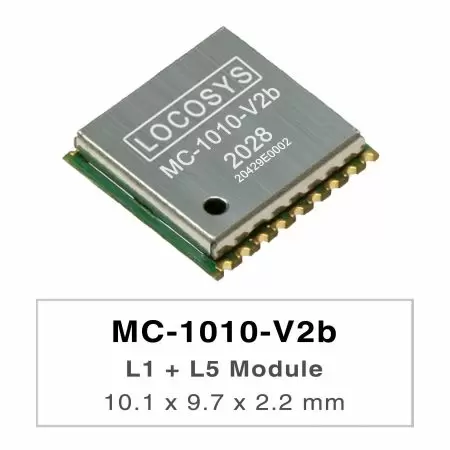
MC-1010-V2b
MC-1010-V2b
LOCOSYS MC-1010-Vxx series are high-performance dual-band GNSS positioning modules that are capable of tracking all global civil navigation systems. They adopt 12 nm process and integrate efficient power management architecture to perform low power and high sensitivity. Besides, concurrent reception of L1 and L5 band signals mitigates the multipath delay and achieves sub-meter position accuracy. The modules support hybrid ephemeris prediction to achieve faster cold start. One is self-generated ephemeris prediction (called EPOC) that is no need of both network assistance and host CPU’s intervention. This is valid for up to 3 days and updates automatically from time to time when GNSS module is powered on and satellites are available. The other is server-generated ephemeris prediction (called EPO) that gets from an internet server. This is valid for up to 14 days. Both ephemeris predictions are stored in the on-board flash memory and perform a cold start time less than 15 seconds. MC-1010-V3x with the active antenna can comply with the sensitivity specification contained in AIS 140 standard. It is the best solution to those customers that design tracking applications in compliance with AIS 140.
-
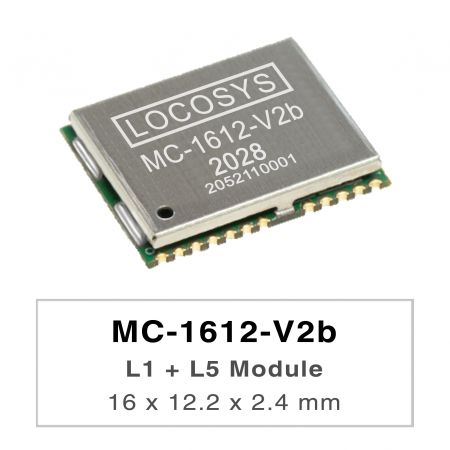
MC-1612-V2b
MC-1612-V2b
LOCOSYS MC-1612-Vxx series are high-performance dual-band GNSS positioning modules that are capable of tracking all global civil navigation systems. They adopt 12 nm process and integrate efficient power management architecture to perform low power and high sensitivity. Besides, concurrent reception of L1 and L5 band signals mitigates the multipath delay and achieves sub-meter position accuracy. The modules support hybrid ephemeris prediction to achieve faster cold start. One is self-generated ephemeris prediction (called EPOC) that is no need of both network assistance and host CPU’s intervention. This is valid for up to 3 days and updates automatically from time to time when GNSS module is powered on and satellites are available. The other is server-generated ephemeris prediction (called EPO) that gets from an internet server. This is valid for up to 14 days. Both ephemeris predictions are stored in the on-board flash memory and perform a cold start time less than 15 seconds The RF front end of MC-1612-V3b the module is specifically designed to comply with sensitivity specification contained in AIS 140 standard. It is the best solution to those customers that design tracking applications in compliance with AIS 140.
-
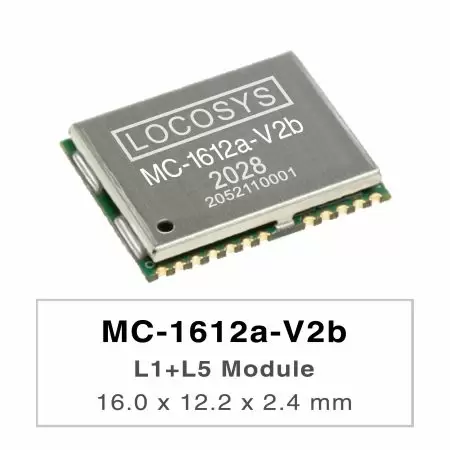
MC-1612a-V2b
MC-1612a-V2b
LOCOSYS MC-1612a-Vxx is a high-performance dual-band GNSS positioning module that is capable of tracking all global civil navigation systems. It adopts 12 nm process and integrates efficient power management architecture to perform low power and high sensitivity. Besides, concurrent reception of L1 and L5 band signals mitigates the multipath delay and achieves more accurate position. The module supports hybrid ephemeris prediction to achieve faster cold start. One is self-generated ephemeris prediction (called EPOC) that is no need of both network assistance and host CPU’s intervention. This is valid for up to 3 days and updates automatically from time to time when GNSS module is powered on and satellites are available. The other is server-generated ephemeris prediction (called EPO) that gets from an internet server. This is valid for up to 14 days. Both ephemeris predictions are stored in the on-board flash memory and perform a faster cold start. The RF front end of MC-161a-V3b the module is specifically designed to comply with sensitivity specification contained in AIS 140 standard. It is the best solution to those customers that design tracking applications in compliance with AIS 140.
-
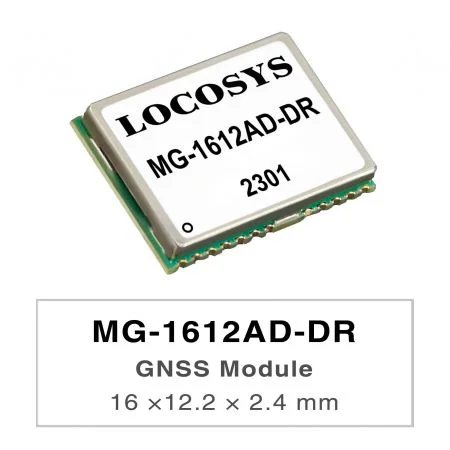
MG-1612AD-DR
MG-1612AD-DR
LOCOSYS MG-1612AD-DR is using an Airoha AG3335AD chip, dual-frequency multi-constellation solution GNSS with sensor fusion dead reckoning module. It not only supports GPS, GLONASS, GALILEO, BEIDOU and QZSS, but also has inertial sensors (3 axis accelerometers and 3-axis gyros) to provide untethered dead reckoning function. In addition to DR, an inertial sensor can detect the vehicular dynamics when it is attached firmly on the vehicle. Consequently, abnormal driving behaviors and the vehicle status can be detected and the alarm status will be enabled to remind the users. No requirement of installation orientation and automatic calibration function make it easy to use. With these features, MG-1612AD-DR can reduce position errors in multipath environment and continue to work where GNSS signals are poor or not available, such as tunnels and indoor parking lots, as well as deliver seamless navigation.
-
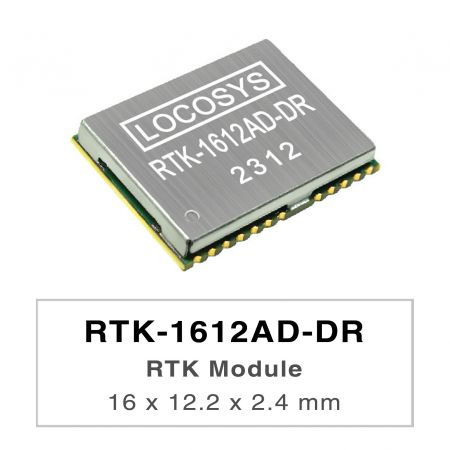
RTK-1612AD-DR
RTK-1612AD-DR
LOCOSYS RTK-1612AD-DR uses an Airoha AG3335AD chip, dual-frequency multi-constellation solution GNSS, providing RTK high precision and sensor fusion solution in one. It not only supports GPS, GLONASS, GALILEO, BEIDOU, and QZSS but also has inertial sensors (3-axis accelerometers and 3-axis gyros) to provide an untethered dead reckoning function. In addition to DR, an inertial sensor can detect the vehicular dynamics when it is attached firmly on the vehicle. Consequently, abnormal driving behaviors and the vehicle status can be detected and the alarm status will be enabled to remind the users. No requirement of installation orientation and automatic calibration function make it easy to use. With these features, RTK-1612AD-DR can reduce position errors in multipath environment and continue to work where GNSS signals are poor or not available, such as tunnels and indoor parking lots, as well as deliver seamless navigation.
-
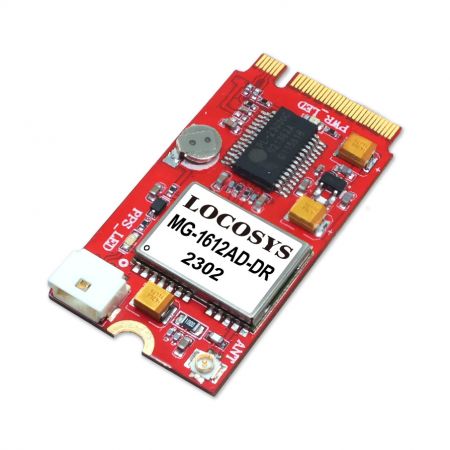
M.2-35AD
M.2-35AD
LOCOSYS M.2-35AD is a L1+L5 high-performance dual-band GNSS RTK module based on the very small industry standard M.2 Type B form factor. Using the USB bus, provides global positioning information, while taking up little space and power within a system. Supporting for Windows and Linux, the M.2-35R can easily integrate into any existing system, as well as easily implemented into new systems. LOCOSYS M.2-35AD builds in LOCOSYS High Precision MC-1612AD-DR module which is using an Airoha AG3335AD chip, dual-frequency multi-constellation solution GNSS with sensor fusion dead reckoning module. It not only supports GPS, GLONASS, GALILEO, BEIDOU and QZSS, but also has inertial sensors (3-axis accelerometers and 3-axis gyros) to provide untethered dead reckoning function. In addition to DR, an inertial sensor can detect the vehicular dynamics when it is attached firmly on the vehicle. Consequently, abnormal driving behaviors and the vehicle status can be detected and the alarm status will be enabled to remind the users. No requirement of installation orientation and automatic calibration function make it easy to use.
-
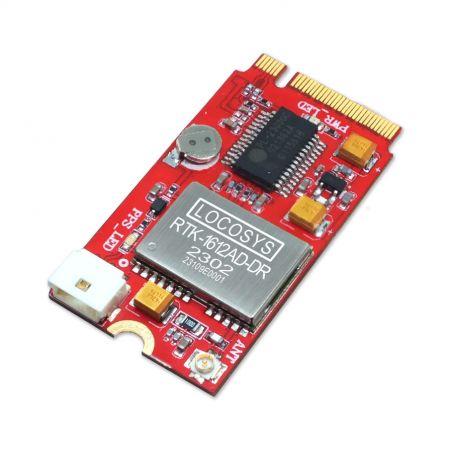
M.2-R35AD
M.2-R35AD
LOCOSYS M.2-R35AD is a L1+L5 high-performance dual-band GNSS RTK module based on the very small industry standard M.2 Type B form factor. Using the USB bus, provides global positioning information, while taking up little space and power within a system. Supporting for Windows and Linux, the M.2-R35AD can easily integrate into any existing system, as well as easily implemented into new systems. LOCOSYS M.2-R35AD builds in LOCOSYS High Precision RTK-1612AD-DR module which is using an Airoha AG3335AD chip, dual-frequency multi-constellation solution GNSS with sensor fusion dead reckoning module. It not only supports GPS, GLONASS, GALILEO, BEIDOU and QZSS, but also has inertial sensors (3-axis accelerometers and 3-axis gyros) to provide untethered dead reckoning function. In addition to DR, an inertial sensor can detect the vehicular dynamics when it is attached firmly on the vehicle. Consequently, abnormal driving behaviors and the vehicle status can be detected and the alarm status will be enabled to remind the users. No requirement of installation orientation and automatic calibration function make it easy to use.
Press Release
-
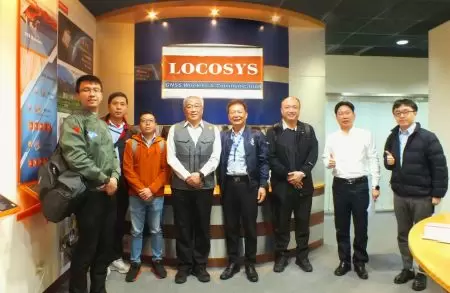 Taiwan Excellence Drone Alliance Visits LOCOSYS Technology, Focusing On Global Positioning Technology And Drone Applications
Taiwan Excellence Drone Alliance Visits LOCOSYS Technology, Focusing On Global Positioning Technology And Drone ApplicationsThe Taiwan Excellence Drone Overseas Business Alliance, led by Yen Tung-Piao,visited a leading smart manufacturing enterprise with a delegation includingrepresentatives from AIDC, the Industrial...
Read More -
 LOCOSYS Showcases Advanced Smart Positioning Technology At New Taipei Electric Vehicle Supply Chain Expo
LOCOSYS Showcases Advanced Smart Positioning Technology At New Taipei Electric Vehicle Supply Chain ExpoTo promote the development of Taiwan's electric vehicle (EV) industry and enhance international collaboration, the New Taipei City Government hosted the Electric Vehicle Supply Chain Expo...
Read More -
 LOCOSYS Technology Unveils New High-Performance SONY GNSS/RTK Global Satellite Positioning Modules
LOCOSYS Technology Unveils New High-Performance SONY GNSS/RTK Global Satellite Positioning ModulesLOCOSYS will showcase its advanced RTK solutions and high-performance GNSS modules, including those powered by Sony’s latest GPS technology, at the 2024 Sensor Expo in Tokyo. These modules,...
Read More

